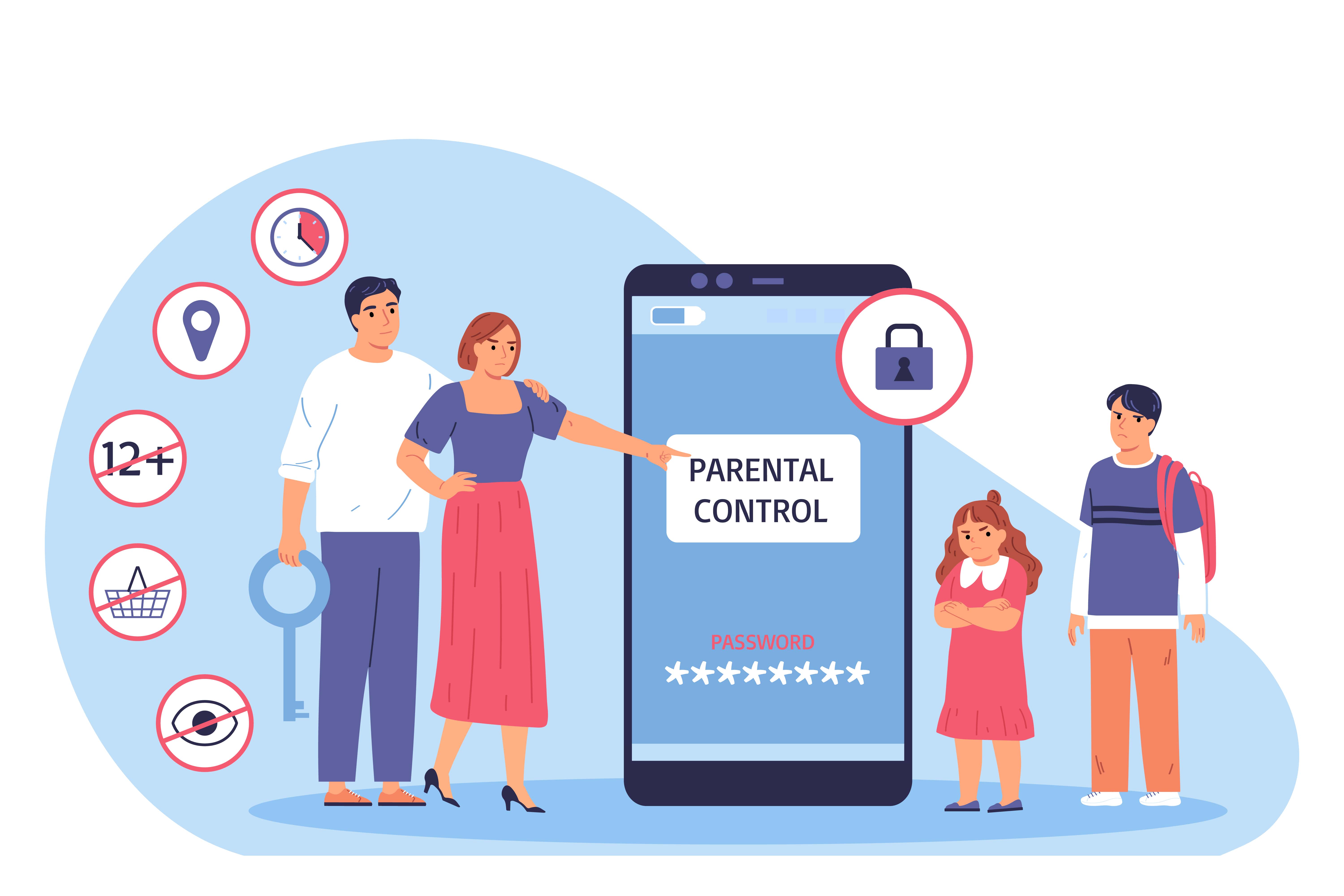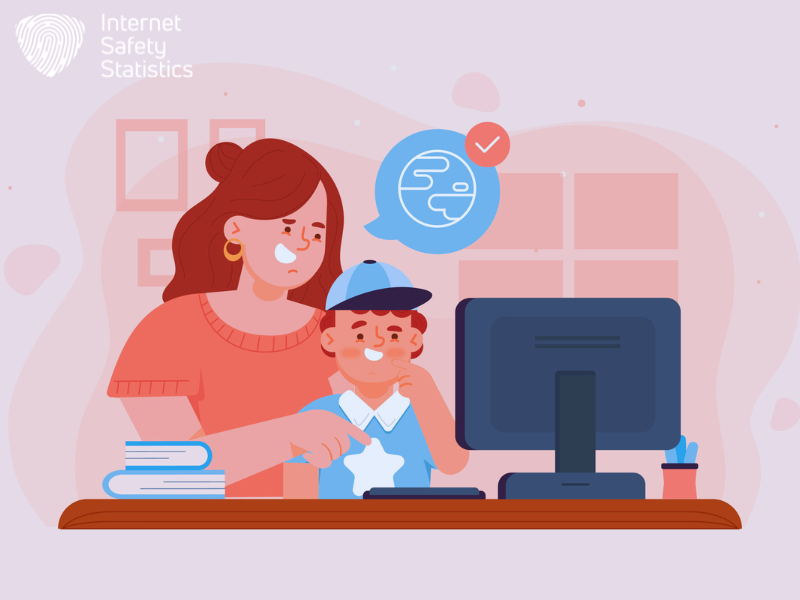
Parental controls are your secret weapon! This blog will show you how to use built-in settings and third-party apps to filter content, manage screen time, and keep your cub safe in the digital jungle. We’ll also discuss the importance of open communication for a well-rounded online safety strategy. Let’s explore!
Table of Contents
Understanding Parental Controls

Parental controls are tools that allow parents to monitor and restrict their children’s online activities. They are important for internet safety as they help protect children from accessing inappropriate content and interacting with potential online threats.
Parental controls are digital toolkits designed to help you steer your child’s online journey in a safer direction. They give you the power to set boundaries around what your child can access on the internet, from blocking adult content to restricting time spent on devices.
With these tools, you can closely monitor which sites and apps your kids visit and whom they interact with online.
By applying age-appropriate settings, parental controls serve as a vigilant gatekeeper against unwanted exposure to harmful content. These software solutions make it easier for you to enforce house rules about screen time and guide your children towards healthier internet habits.
Whether it’s through filtering out mature material or keeping tabs on social media use, these measures shield young eyes while fostering an environment where exploration is both fun and safe.
Parental Controls and Internet Safety
Understanding the significance of parental controls for internet safety is crucial. Parental controls play a vital role in safeguarding children against exposure to inappropriate content and potential online risks.
By implementing these controls, parents can regulate their children’s online activities, limit screen time, block adult material, and enforce safe browsing habits. With the increasing prevalence of digital devices and online platforms accessible to children, parental controls provide an essential layer of protection to ensure that kids have a safer and more secure online experience.
Parents, office workers, and internet users are presented with numerous challenges in managing the online safety of young individuals. The use of parental control tools serves as an effective strategy alongside other measures to mitigate potential risks associated with unsupervised internet usage by children.
It empowers adults with the necessary means to oversee their children’s interactions on digital platforms while also promoting responsible digital citizenship among younger generations.
Setting Up Parental Controls on Devices
Ensure your home Wi-Fi network has parental controls enabled to filter content and monitor online activity. Set up age-appropriate restrictions on desktops, laptops, mobile devices, gaming consoles, and smart TVs to protect your child from inappropriate content.
Home Wi-Fi Network
Setting up parental controls on your home Wi-Fi network is a crucial step in ensuring online safety for your children. Here’s how to do it effectively:
- Access your Wi – Fi router’s settings by typing its IP address into a web browser and logging in with the admin credentials.
- Locate the “Parental Controls” or “Access Control” section within the router settings.
- Set up content filtering by blocking specific websites or categories of content that are not suitable for children.
- Establish time restrictions to limit the amount of screen time your child can have on their devices.
- Consider enabling device monitoring to track which devices are connected to your network and what they are accessing.
- Create separate profiles for each child if your router supports it, allowing you to customise settings based on age-appropriate requirements.
- Regularly review and update the parental control settings as needed to ensure they remain effective and relevant.
Desktop and Laptop Computers
Set up parental controls on desktop and laptop computers to protect your child’s online experience. Start by accessing the system settings or control panel of the computer. Look for the parental control options within the settings. Once found, set up user accounts for children with age-appropriate restrictions and privacy settings. Monitor their browsing history and online activities to ensure a safe online environment. Consider using third-party software for additional features such as time management and content filtering.
Mobile Devices (Apple and Android)
Parental controls are essential for mobile devices to protect children from inappropriate content and online risks. These settings can be activated on both Apple and Android devices to ensure a safer online experience for kids.
- Set age – appropriate content filters to block or restrict access to adult material, violent content, and explicit websites.
- Use privacy controls to limit the sharing of personal information and location tracking when your child is using apps or browsing the internet.
- Implement screen time management tools to set limits on the amount of time your child spends on their mobile device, promoting healthy digital habits.
- Activate safe search settings within web browsers and search engines to filter out potentially harmful or explicit content from search results.
- Install reputable parental control apps available in app stores that offer features like website filtering, app monitoring, and activity reports.
Gaming Consoles and Smart TVs
- These controls typically include options to set age restrictions for games, films, and TV shows, helping you ensure age-appropriate content.
- You can also manage which online services are accessible and control spending on gaming platforms.
- Some devices may provide time limits for usage, enabling you to regulate screen time effectively.
- Parental controls on smart TVs can allow you to block specific channels or programs based on content ratings, ensuring a safer viewing experience.
- Additionally, these features can help prevent unauthorised purchases and protect children from potentially harmful content while using gaming consoles and smart TVs.
Using Third-Party Software
Utilise commercial software, Google Family Link, and mobile service providers to enhance online protection for children. Read on to discover how these tools can help keep your kids safe online.
Commercial Software
Commercial software offers advanced features for setting up parental controls on various devices, providing comprehensive protection for children’s online activities. It ensures age-appropriate content filtering and monitors online behaviour effectively. Here are the features of commercial software:
- Advanced Content Filtering: Commercial software enables parents to block inappropriate websites and filter out adult content, ensuring a safer online experience for kids.
- Time Restrictions: It allows parents to set screen time limits, restricting the amount of time children spend online or on specific apps.
- Cybersecurity Protection: These solutions offer robust security measures to protect children from cyber threats, such as malware and phishing attempts.
- Activity Monitoring: Commercial software provides detailed insights into a child’s online activity, allowing parents to monitor websites visited and applications used.
- Social Media Controls: Some commercial software tools offer specific controls for social media platforms, enabling parents to monitor and limit their child’s interactions.
- Usage Reports: Parents can receive regular reports detailing their child’s online behaviour, empowering them with information to address any concerns proactively.
Google Family Link
Google Family Link is a free app that helps parents manage the content their children can access on devices. It allows parents to set digital ground rules by managing the apps, keeping an eye on screen time, and reviewing their child’s device usage.
- Monitor Screen Time
- Manage Apps
- Set Device Bedtimes
- Locate Their Child’s Device
- Set Up Filters
- Remote Control
Mobile Service Providers
Mobile service providers offer parental control features that can help you manage and monitor your child’s online activities. Here are several ways in which you can utilise these features:
- Access controls: You can set up age-appropriate content filters and block certain websites or apps that are not suitable for your child’s age group.
- Time restrictions: You have the option to limit screen time by setting specific hours during which your child can access the internet or use certain apps.
- Usage monitoring: Many mobile providers offer tools to keep track of your child’s online usage, including the websites they visit and the amount of time spent on particular apps.
- App restrictions: These features allow you to control which apps your child can download and use, providing an additional layer of security.
- Communication controls: Some providers enable you to manage who your child communicates with by setting limits on text messaging, calls, and social media interactions.
Setting Restrictions on Streaming Services
When it comes to streaming services, it’s important to set restrictions and filters to ensure that your children only have access to age-appropriate content. This can be done through the parental control settings on platforms like Netflix Kids & Families and other streaming services.
Netflix Kids & Families
- Parental controls on Netflix allow you to set maturity ratings for each profile, ensuring that your child can only access content suitable for their age group.
- You have the option to block specific titles or entire series from appearing in your child’s profile.
- Utilise the viewing activity feature to monitor what your child has been watching.
- By setting up PIN protection, you can prevent your child from accessing certain content without your permission.
- Take advantage of the ability to turn autoplay on or off, giving you more control over how much time your child spends watching.
Other Streaming Platforms
- Amazon Prime Video: Parents can set age restrictions and create individual profiles for younger viewers, allowing them to access only age-appropriate content.
- Hulu: The platform allows users to create separate profiles for each family member, with options to filter mature content based on age ratings.
- Disney+: Parents can set up kids’ profiles with access only to child-friendly content, ensuring a safe viewing experience.
- YouTube Kids: This platform offers a more controlled environment specifically designed for kids, with parental control features such as content filtering and screen time limits.
- BBC iPlayer: Parents can apply parental controls to restrict access to specific programmes or limit playback duration for children.
Additional Tips for Online Safety

Encourage safe browsing habits, introduce child-friendly search engines and enforce safe search settings. Keep an eye on your child’s online activity and remember that parental controls have limitations.
Safe Browsing Habits
To ensure online safety for kids, it is crucial to foster safe browsing habits. Parents can guide children on how to navigate the internet responsibly by teaching them to only visit age-appropriate websites and avoid clicking on unfamiliar links or pop-ups.
Additionally, setting up child-friendly search engines and enabling safe search settings can further protect kids from stumbling upon inappropriate content. Monitoring your child’s online activity is essential in ensuring they are following safe browsing habits and avoiding potentially harmful websites.
Furthermore, educating children about the importance of keeping personal information private while online contributes significantly to their digital safety. Teaching them not to share sensitive details such as their full name, address, or school information with strangers can help prevent potential risks associated with cyber interactions.
Child-Friendly Search Engines
Child-friendly search engines provide a safer online browsing experience for children. These search engines filter out inappropriate content and prioritise age-appropriate results, giving parents peace of mind while their kids are exploring the internet.
With features like safe search settings and content filtering, child-friendly search engines help to protect young users from stumbling upon harmful material or engaging with unsafe websites.
Using child-friendly search engines can significantly reduce the risk of exposure to inappropriate content and ensure that your children have a safer online experience. Parents should consider integrating these platforms into their internet safety strategy alongside setting up parental controls on devices, enforcing safe browsing habits, and monitoring their kids’ online activities.
By incorporating child-friendly search engines into your approach to internet safety, you can further enhance the protection of your children’s online experiences.
Safe Search Settings
To ensure a safer online experience, enable safe search settings on search engines. This will help filter out inappropriate content and ensure that children are exposed to age-appropriate material when browsing the internet.
By activating safe search settings, you can prevent your child from stumbling upon adult or harmful material while conducting online research or simply using the web for entertainment.
Setting up safe search settings is an essential step in protecting children’s online safety. It allows parents to have better control over the type of content their kids can access, providing peace of mind and a safer digital environment for young users.
Monitoring Your Child’s Online Activity
It’s crucial to stay aware of your child’s online activity, including the websites they visit and the content they engage with. Regularly checking their browser history and monitoring their social media interactions can help you understand their online behaviour and intervene if necessary.
Setting aside time to have open conversations about what they’re doing online is essential for maintaining a trusting relationship and ensuring their safety.
By actively monitoring your child’s digital activities, you can detect any potential red flags or signs of inappropriate conduct early on. Communicating openly and honestly with your child about the importance of safe internet usage will encourage them to approach you whenever they encounter something that makes them feel uncomfortable or threatened.
The Limits of Parental Controls
While parental controls are effective in filtering content and monitoring online activities, it’s essential to recognise their limitations. Parental controls cannot replace open communication with your child about internet safety and responsible online behaviour.
Additionally, they may not be foolproof and could potentially be bypassed by tech-savvy children. It’s important for parents to understand that parental controls should complement active supervision rather than serve as a substitute.
Moreover, these tools can only control what happens within the digital realm – they do not address real-world risks associated with social interactions or cyberbullying. Therefore, it’s crucial for parents to emphasise a holistic approach to online safety which includes education, trust-building conversations, and setting clear expectations around technology use.
Conclusion
In conclusion, parental controls play a crucial role in ensuring children’s online safety. These tools allow parents to monitor and control what their kids can access on the internet.
By setting age-appropriate restrictions and monitoring online activities, parents can provide a safer digital environment for their children. Effective use of parental controls requires proactive involvement and regular adjustments as children grow and gain more independence online.
Establishing a balance between supervision and privacy empowers children to explore the online world while safeguarding them from potential risks.
